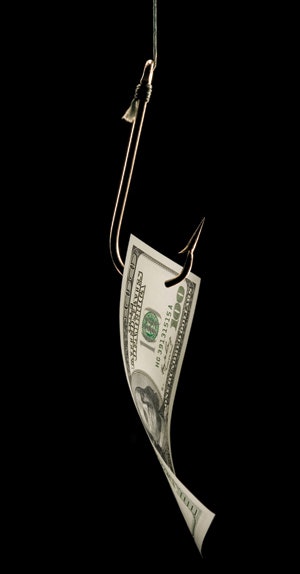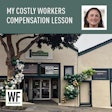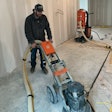

When you fish, your goal is to catch the big one. Before you go fishing, though, you need a license. Your bid is like a license to go fishing for an opportunity to negotiate and land a great contract. So you set out to find a fishing hole and cast your bait-hook, line and sinker. When looking for great companies to bid to or looking for profitable projects to bid on, you also seek out opportunities that will give you the best chance to make the most money. When you finally catch a fish, you reel it in, weigh it, and decide if you want to keep it. Likewise, after you get the call to cut your bid or match a better price to get the job, it is your choice to accept their offer or not.
When you go fishing and they aren't biting, what do you do? You try different techniques, change your bait, or move on to another fishing hole. Strangely, this is not what contractors typically do when they don't land enough contracts. Most just keep bidding the same way over and over, using the same bait and proposal strategies they've always used. Contractors often think if they bid enough jobs to the same customers, eventually they'll get their share, but this won't get you the positive results you want. As with fishing, you must change your estimating and bidding strategies to get the big ones to bite more often. In the end, your goal should be to improve your "bid-hit ratio."
Bid-Hit Ratio
When I speak at construction conventions or company meetings, I ask people what their bid-hit ratio is. Unfortunately, most business owners, estimators, and project managers don't have a clue. To me, this is like going fishing and not really caring if you catch any fish.
The bid-hit ratio can be thought of as the rate at which you successfully bid or propose on projects. For example, a 5:1 bid-hit ratio shows that for every five jobs you bid on, you are awarded one. Do you know what yours is? I have asked over 5,000 general contractors, builders, and subcontractors what a good bid-hit ratio is, and their responses vary from a perfect 1:1 to a poor ratio of 35:1.
Which is the best ratio for you? Obviously, the lower the ratio, the better. In the end, though, the right ratio is what works for your company. A 35:1 ratio is too high and 1:1 is nearly impossible. The highest reasonable ratio for large companies should not exceed 10 or 11:1. Higher than 11:1 will cost your company too much in estimating expenses and won't provide a reasonable profit. For smaller companies, I recommend to strive for a 4:1 ratio or less.
Keeping Track
In order to determine how many jobs to bid and what type of jobs to go after, you must know your bid-hit ratio for the different categories. Track it monthly, quarterly and yearly. Track it for all types of projects and each potential customer. Also, track by type: large versus small, commercial versus residential, or new building versus remodeling.
As you study your bid-hit ratio trends, you'll find certain customers give you more work than others. You'll find you do better with certain kinds of jobs. You'll also discover when competing against too many competitors, your success ratio won't be as good as it should be. This simple tracking system will help you determine which jobs and customers to bid to. It will also help you determine when to eliminate a project type or customer.
Improving Your Bid-Hit Ratio
When this is all done effectively, your bid-hit ratio will improve. Here are a few other steps to improving it.
1. Offer what your customers want.
Think about what you include in your typical proposal or bid. You automatically include things like price, terms, scope of work, inclusions, exclusions and payment provisions. These facts and figures don't take into consideration what your customer really wants. Sure, they want a low price, but what else?
If you wanted to hire a remodel contractor to add on to your home while you continued to live there, would price be the No. 1 factor in selecting your professional contractor? What about disruption to your life, keeping the house clean, noise, security, scheduling, integrity, financial strength, manpower, supervision, etc.?
Every project has unique requirements that are often as or more important than price. Before you start working on an estimate for a customer, always ask the decision maker: What are the top three most important deciding factors when selecting contractors and awarding contracts on this project? What would set us apart from the other bidders?
Next, custom design your bid proposal accordingly and highlight the differentiating factors. Always ask what your customer needs before you submit your bid, and you'll be surprised how often price is not the most important factor.
2. Be in the people business.
Busy contractors realize that getting profitable work requires using different tactics than those of their competitors. And even more important is to realize that bidding is only a small part of the sale. Being awarded a profitable contract starts with getting your customers to want to give you good jobs at your price.
Think about the personal relationships and friendships you have. They were nurtured over time and stayed strong because of the time you spent together. Business relationships are no different-they are also built face-to-face and are often the deciding factor when procuring construction work. Sometimes brave contractors call their customers after submitting bids and ask, "How do I look?" The only response you'll ever get to this is, "Cut your bid and then you'll look better!" Instead, give customers a reason to call you. And remember: Only face-to-face meetings improve your bid odds dramatically.
3. Only bid what you do best.
Over the years we wasted lots of time and money chasing work we wouldn't get and didn't really want. Once we decided to specialize and focus on certain types of projects, in specific locations, for certain types of customers, we improved our bid-hit ratio dramatically.
The next big decision we made was to define the ideal job size to target by creating the minimum profit margin we wanted on every job. We decided to "just say no" by setting a minimum fee, and this eliminated most of the small projects we had previously done. The last decisions we made were to primarily seek negotiated jobs and never bid or propose on projects against more than three quality competitors. These bold and scary decisions transformed us from a "too-busy, low-profit" company selling price into an above-average, profitable company with loyal repeat customers who use only our services and give us lots of referrals.
4. Know your job costs.
The key to a good bid is arriving at accurate job costs. The estimator does his job perfectly when the final job costs equal the project estimate and budget; we give our estimators bonuses when this happens. The only variables between your bid and the completed project should be overhead and profit markup.
5. Get on the right bid lists.
One of the best ways to improve your bid-hit ratio is to get on the right bid lists, and this starts by keeping track of your bid-hit ratios. Another important factor is to have a bidding strategy with goals to shoot for. When we bid a job, we strive to be among a small group of competitors and only bid when our odds are greater than 66 percent.
Our specific strategies may not work for your company, but you can use these techniques to find the strategies that work for you. Sit down and develop a bidding strategy that fits within your business strengths, plans, and goals.






























